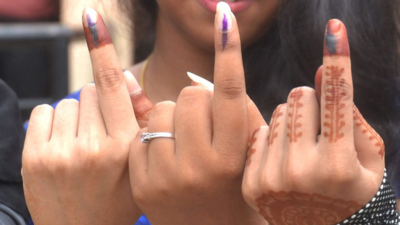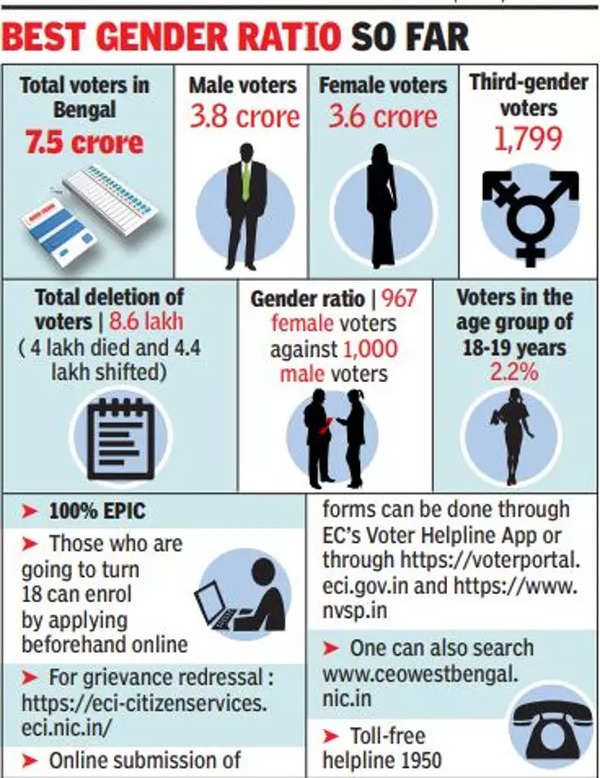Top Searches
- News
- City News
- kolkata News
- West Bengal has 967 female voters for 1,000 men
West Bengal has 967 female voters for 1,000 men

In the last seven years, the gender ratio of voters in Bengal has increased from 934 female voters per 1,000 male voters in 2016 to 967 in the final electoral roll data released by the Election Commission on Thursday.
KOLKATA: In the last seven years, the gender ratio of voters in Bengal has increased from 934 female voters per 1,000 male voters in 2016 to 967 in the final electoral roll data released by the Election Commission on Thursday.

This is the best recorded gender ratio in Bengal. Among the 7.5 crore voters in the state, 3.6 crore are female.
Female voters form 49.1% of the state's electorate.
The EC data shows that there has been an addition of 17.8 lakh voters while names of 8.6 lakh voters have been deleted from the electoral rolls. Among those deleted, over four lakh have died and 4.4 lakh people have moved out of Bengal. There were some names which were repeated in the electoral rolls.
According to this data there are 1,799 third gender voters in Bengal. There are 1.1 lakh service voters in Bengal. The state, according to the EC, has a 100% EPIC coverage.
In 2016, an official said, the gender ratio was 934 female voters per 1,000 male voters. This rose to 938 in 2017, 942 in 2018, 949 in 2019 and 956 in 2020. In 2021, the gender ratio was 966 females out of 100 males.
Last year, according to the electoral roll issued by EC, there were 7. 4 crore voters in Bengal.
In 2021, Bengal has 3. 7 crore male voters and 3. 6 crore female voters.
During the 2021 Bengal assembly polls, women matched men when it came to voting. Around 81.7% women and 81.4% men turned up to cast their votes. Over 2.9 crore of Bengal's 3.5 crore women voters stepped out to vote, braving the pandemic amid a protracted election schedule.
"Voting is also an assertion of rights," said Ruby Sain, a professor of sociology at Jadavpur University, adding, "Women, through their votes, wanted to secure their rights. And it is a powerful message. The education level among women is going up, and parents are playing a key role in encouraging their daughters. Parents, too, are breaking the gender divide at home."
Joydev Majumdar, director, Jaiprakash Institute of Social Change, attributed this to gender empowerment, which has led to more political awareness among women.
"Literacy has been a key factor. This is surely a healthy index for a robust society. But political parties need to bring more women to decision-making bodies," he said.

This is the best recorded gender ratio in Bengal. Among the 7.5 crore voters in the state, 3.6 crore are female.
Female voters form 49.1% of the state's electorate.
The EC data shows that there has been an addition of 17.8 lakh voters while names of 8.6 lakh voters have been deleted from the electoral rolls. Among those deleted, over four lakh have died and 4.4 lakh people have moved out of Bengal. There were some names which were repeated in the electoral rolls.
According to this data there are 1,799 third gender voters in Bengal. There are 1.1 lakh service voters in Bengal. The state, according to the EC, has a 100% EPIC coverage.
In 2016, an official said, the gender ratio was 934 female voters per 1,000 male voters. This rose to 938 in 2017, 942 in 2018, 949 in 2019 and 956 in 2020. In 2021, the gender ratio was 966 females out of 100 males.
Last year, according to the electoral roll issued by EC, there were 7. 4 crore voters in Bengal.
In 2021, Bengal has 3. 7 crore male voters and 3. 6 crore female voters.
During the 2021 Bengal assembly polls, women matched men when it came to voting. Around 81.7% women and 81.4% men turned up to cast their votes. Over 2.9 crore of Bengal's 3.5 crore women voters stepped out to vote, braving the pandemic amid a protracted election schedule.
"Voting is also an assertion of rights," said Ruby Sain, a professor of sociology at Jadavpur University, adding, "Women, through their votes, wanted to secure their rights. And it is a powerful message. The education level among women is going up, and parents are playing a key role in encouraging their daughters. Parents, too, are breaking the gender divide at home."
Joydev Majumdar, director, Jaiprakash Institute of Social Change, attributed this to gender empowerment, which has led to more political awareness among women.
"Literacy has been a key factor. This is surely a healthy index for a robust society. But political parties need to bring more women to decision-making bodies," he said.
Start a Conversation
FOLLOW US ON SOCIAL MEDIA
FacebookTwitterInstagramKOO APPYOUTUBE









